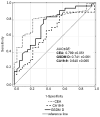Gasdermin D (GSDM D) as a Potential Diagnostic Biomarker in Bladder Cancer: New Perspectives in Detection
- PMID: 39766111
- PMCID: PMC11674414
- DOI: 10.3390/cancers16244213
Gasdermin D (GSDM D) as a Potential Diagnostic Biomarker in Bladder Cancer: New Perspectives in Detection
Abstract
Background: Traditional methods of bladder cancer (BC) diagnosis include clinical examination, imaging, urine tests, cystoscopy, and biopsy. Due to the complexity of detection, diagnostic markers of bladder cancer measured in blood are still being sought. The pathogenesis of BC is complex and depends on many factors. However, the available literature data suggest that gasdermin D (GSDM D) has an influence in the pathogenesis of cancers. This study is the first that assesses the significance and diagnostic utility of serum GSDM D in bladder cancer.
Methods: A total of 80 serum samples were obtained and analysed from healthy volunteers (C) and bladder cancer patients. The cancer patients were further classified into two groups, low-grade (LG) and high-grade (HG) bladder cancer, according to the TNM classification. The serum levels of GSDM D, CEA, and CA19-9 were assessed following the manufacturer's instructions using immunoassay techniques.
Results: The concentrations of GSDM D were nearly twice as high in the serum of BC patients compared to controls. Additionally, the median of GSDM D concentration was notably elevated in LG and HG bladder cancer than in C. In the total study group, the GSDM D concentration correlated with CRP and CEA levels. The diagnostic sensitivity of GSDM D was higher than that of CEA, but slightly lower in comparison to CA19-9. Moreover, the negative predictive value of GSDM D was the highest among all tested markers. The highest positive predictive value and diagnostic accuracy were observed for CEA, while the accuracy of GSDM D was comparable. GSDM D had an AUC value of 0.741, which was similar to the AUC value of CEA.
Conclusions: GSDM D in serum appears to be a valuable diagnostic biomarker, especially when its measurement is used in conjunction with other markers such as CEA. Its high sensitivity makes it effective for the early detection of bladder cancer.
Keywords: GSDM D; bladder; cancer; diagnosis; gasdermin; tumour marker.
Conflict of interest statement
The authors declare no conflicts of interest.
Figures


Similar articles
-
The Clinical Significance of Serum Free Light Chains in Bladder Cancer.J Clin Med. 2023 May 5;12(9):3294. doi: 10.3390/jcm12093294. J Clin Med. 2023. PMID: 37176734 Free PMC article.
-
Diagnostic predictive value of Xpert Bladder Cancer Monitor in the follow-up of patients affected by non-muscle invasive bladder cancer.J Clin Pathol. 2019 Feb;72(2):140-144. doi: 10.1136/jclinpath-2018-205393. Epub 2018 Oct 24. J Clin Pathol. 2019. PMID: 30355587
-
Gasdermin D deletion prevents liver injury and exacerbates extrahepatic damage in a murine model of alcohol-induced ACLF.eGastroenterology. 2025 Mar 22;3(1):e100151. doi: 10.1136/egastro-2024-100151. eCollection 2025. eGastroenterology. 2025. PMID: 40134717 Free PMC article.
-
Methylated Septin 9 as a Promising Biomarker in the Diagnosis and Recurrence Monitoring of Colorectal Cancer.Dis Markers. 2022 Jul 2;2022:7087885. doi: 10.1155/2022/7087885. eCollection 2022. Dis Markers. 2022. PMID: 35818587 Free PMC article. Review.
-
The Diagnostic Accuracy of Cystoscopy for Detecting Bladder Cancer in Adults Presenting with Haematuria: A Systematic Review from the European Association of Urology Guidelines Office.Eur Urol Focus. 2024 Jan;10(1):115-122. doi: 10.1016/j.euf.2023.08.002. Epub 2023 Aug 24. Eur Urol Focus. 2024. PMID: 37633791
References
LinkOut - more resources
Full Text Sources
Research Materials
Miscellaneous

